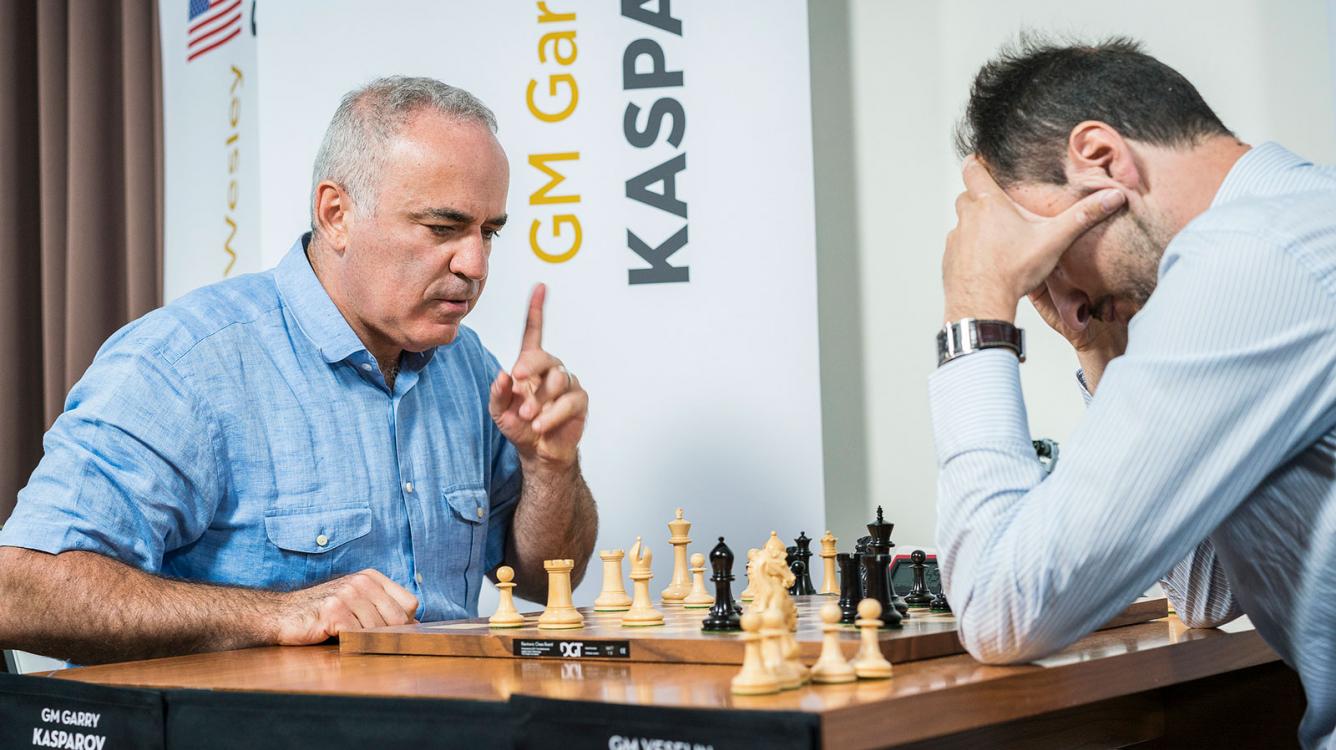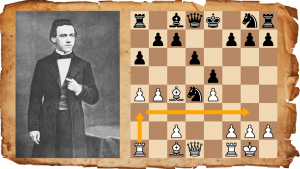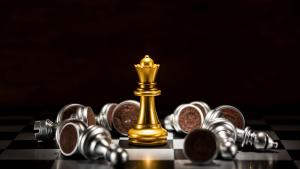
Who Invented Closed Chess Games?
One of the most interesting aspects of the recent chess960 matches (featuring Garry Kasparov) in St. Louis, was their potential to develop some kind of rudimentary opening theory. It appears that the players enjoyed this opportunity as well.
As Peter Doggers wrote:
[T]he players get to spend an hour before the start [...] to prepare in the playing hall. For instance, on day two the Americans Nakamura, Shankland and So worked together; Aronian sat down with MVL and Kasparov analysed with Svidler. Giri worked with his regular second, Erwin l'Ami. They seem to enjoy this analytical session (without reaching a clear conclusion about what is the best first move!), like they seem to enjoy their laptop-free mornings!
When I played my own first official chess960 event, earlier this year in Reykjavik, I felt the same excitement. Here was an opportunity to be a true pioneer in chess! To discover genuine opening setups, configurations and ideas, and to boldly go where no chess player has gone before!

Did the chess players who lived hundreds of years ago feel the same way? It's tempting to think that they did, but the evidence is not conclusive. Whereas the players in St. Louis tried out different opening moves (and follow-up sequences) in the limited number of games they played, the chess masters of the old days were remarkably, almost inexplicably one-sided in their preference for 1.e4.
The Göttingen Manuscript (dated approx. 1510) does mention the moves 1.c4, d4 and 1.f4 as well, and the historian Murray (1913) writes that the author of the manuscript probably derived these moves from the medieval form of chess that was played until the end of the 15th century.
The move 1.d4 is known to have been quite common as a first move in the Middle Ages, but with the rise of the popularity of modern chess, focus of analysts and players quickly shifted almost exclusively to 1.e4, opening up lines for the queen and bishop.
Compared to the thousands of opening variations developed around 1.e4 e5 (the so-called open games) during the 16th and 17th centuries, we find only a very limited amount of lines with the closed games (and even less with other moves) in chess literature. Isn't it odd that such as natural and logical move sequence got so little attention?
Some basic variations in the Queen's Gambit Accepted can be found in Damiano (1512), and in a game between the Italians Giovanni Saduleto and Benavides, played in 1590, mentioned by Polerio. There also is an obscure consultation game played in 1606 between Salvio and Cascio, starting with the moves 1.d4 d5 2.c4 c5. These games, however sparse, prove that the closed games did occur in practice and were taken at least somewhat seriously by the leading players of that time.
But the first appearance of the Queen's Gambit Declined (2...e6) can only be found in Pietro Carrera's book Il Gioco de gli scacchi di D. Pietro Carrera, diviso in otto libri, published in 1617—that's 130 years after the birth of modern chess! After the move 2...e6, he further analyzes the moves 3.Nc3 Nf6, which are still the main moves played today.

Medallion of Pietro Carrera, after an original portrait from around 1624
Pietro Carrera (1573-1647) was regarded as an important chess theoretician already in his own time, and with hindsight, this is even more apparent. Born near Syracuse, Sicily, he contributed to the earliest theory of the Sicilian Defense, preferring the healthy move 2.c3 (nowadays called Alapin Variation) above then-popular moves like 2.f4, 2.b4 and 2.Bc4. He also analyzed the still-popular Alekhine Variation in the Slav: 1.d4 d5 2.c4 c6 3.Nc3 dxc4 4.e4, and the first Semi-Slav set-ups with ...e7-e6. It's not unreasonable to call Pietro Carrera the father of the closed games.
The Queen's Gambit Declined (QGD) wasn't seriously analyzed for almost another century, until the Syrian chess master Philipp Stamma (ca. 1705-1755) picked it up and wrote about it in his book Essai sur le jeu des echecs (1737). (In this book, he also introduced the algebraic notation we still use today.) In fact, the Queen's Gambit is still sometimes called the Aleppo Gambit, named after the Syrian city where Stamma was born.
Unfortunately, no games by Stamma in the Queen's Gambit seem to have survived. He does mention some lines in his book, such as the well-known trap 1.d4 d5 2.c4 dxc4 3.e3: "It is better to play this pawn two squares; if your adversary defend the Gambit Pawn (which he ought not to do), you will, however, gain more by having advanced this Pawn one square than two squares." 3...b5 "The Black [player] loses the game by this move; it must be observed that the Gambit Pawn cannot be successfully defended in the Queen's Gambit." 4.a4 c6 5.axb5 cxb5 6.Qf3
The quotes are taken from the book Stamma on the Game of Chess (1819) by William Lewis.

Looking at the chess literature from the 18th and early 19th centuries now, it is truly remarkable how little attention the closed games received. Writing in 1808, the chess author J.H. Sarratt remarked, "You may safely begin the game by playing the Queen's Pawn two steps, as by playing the King's." But he didn't bother giving more than one of two illustrative games with it. John Cochrane wrote in his Treatise on Chess, published in 1822, that "the openings from the Queen's side admit of little variety," and then analyzes just a handful of possibilities.
And here's W.Lewis writing in his The Game of Chess about the Queen's Gambit as late as 1844:
The Queen's Gambit is neither so interesting nor so instructive as the King's Gambit, but it is considered a safer game for the first player [i.e. White], as in all cases, with correct play, his position will be at least equal to his adversary's: this arises chiefly from the second player [Black] not being able to defend the Gambit Pawn, as in the King's Gambit.
Howard Staunton was one of the first players to advocate the move 2...e6. In those early days, Black usually intended to follow up with with the active...c7-c5 (nowadays called Tarrasch Defense). It was Staunton again who noted a truism that still holds today, namely that in the QGD, "it is a curious feature that the Queen's Bishop can rarely be played over to the King's side with advantage."
 A page from Staunton's The Chess Player's Handbook (first published 1847).
A page from Staunton's The Chess Player's Handbook (first published 1847).
It took until the 1830s before the first serious games in the Queen's Gambit and the Slav Defense were recorded. An early match game between De Labourdonnais and Macdonnell started 1.d4 d5 2.Bf4 and De La Bourdonnais played the QGD with Black occasionally.
The following game makes a rather modern impression:
While playing through some of the 1.d4 d5 games of these days, it almost felt to me as if this more frequent deployment of the closed games was evidence of some kind of "parallel universe" in the 19th century, where any notion that pieces could be sacrificed as readily as in the open games, simply didn't exist! Would you have guessed the game below was from the "Romantic Era," if you didn't see the year it was played in?
The player with the white pieces is mainly known as the loser of the "Immortal Game" he played against Adolf Anderssen (note the enormous difference in style between this game and that beloved gem by Anderssen!). As this game shows, Lionel Kieseritzky was a very interesting player in his own right! Actually, this game was, in my opinion, the first modern occurrence of the QGD.
Starting in the 1840s, the opening became more and more popular. A year after Kieseritzky's game, Staunton played it again several times in his match against the very strong player De Saint Amant, and in the 1850s it was even picked up by the American genius Paul Morphy.
The rest is history. Wilhelm Steinitz used the Queen's Gambit successfully against Zukertort in the first official world championship match, in 1886, and the QGD has been seen in virtually every world title match ever since.
When we think of the 19th century, also called the "Romantic Era," we tend to recall only those games in which people only played the King's Gambit or the Evans Gambit. But it was also the century in which the closed games were first taken seriously.
So next time you see a Queen's Gambit at top grandmaster level, don't think of Lasker, Capablanca or Botvinnik. Think of Pietro Carrera, Philipp Stamma, Howard Staunton or Lionel Kiezeritsky.
They were the true pioneers of this chess opening—just like we all are in chess960.



